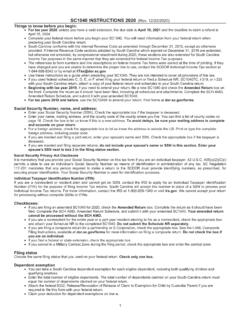Transcription of Salaries in Psychology - American Psychological Association
1 Salaries in Psychology Findings from the national Science Foundation s 2015 national Survey of College Graduates American Psychological Association Center for Workforce Studies Luona Lin, Peggy Christidis, and Karen Stamm May 2017 Recommended citation: American Psychological Association . (2017). Salaries in Psychology : findings from the national Science Foundation s 2015 national Survey of College Graduates. Washington, DC: Author. This report describes research and analysis conducted by staff members of the American Psychological Association s Center for Workforce Studies. It does not constitute official policy of the American Psychological Association . The use of data from the national Science Foundation does not imply NSF endorsement of the research, research methods or conclusions contained in this report. The authors thank Howard Kurtzman and Jaime Diaz-Granados for valuable input on previous drafts of this report. The American Psychological Association s Center for Workforce Studies is responsible for the collection, analysis and dissemination of information relevant to the Psychology workforce and education system.
2 Through the use of surveys, federal statistics and data mining, the Center gathers information about the profession of Psychology , including its scientific and educational communities, practitioners, and psychologists working in the public interest. For questions regarding this report, please contact the APA Center for Workforce Studies at or 1-800-374-2721 (extension 5980) Table of Contents Executive Summary .. 1 Introduction .. 2 Section 1. Overview .. 3 Section 2. Professional Service Positions .. 8 Section 3. Teaching Positions .. 11 Section 4. Research Positions .. 13 Section 5. Management Positions .. 15 Section 6. Salaries by Demographic Characteristics .. 17 Conclusion .. 19 References .. 20 Appendix A. Technical Documentation .. 21 Appendix B. Data underlying Figures .. 26 Figures Figure 1. Salary Distribution, 3 Figure 2. Median Salary by Geographic Division, 2015 .. 4 Figure 3. Median Salaries by Field of Highest Degree, 2015 .. 5 Figure 4. Salaries by Position Type, 2013-15.
3 7 Figure 5. Median Salary by Gender and Racial/Ethnic Groups, 17 Figure 6. Median Salary by Age Group, 2015 .. 18 Tables Table 1. Salaries by Degree Type, 2015 .. 4 Table 2. Definition of Position Types .. 6 Table 3. Salaries by Position Type, 2015 .. 7 Table 4. Salaries for Professional Service Positions, by Sector, 2015 .. 8 Table 5. Salaries for Professional Service Positions in the Private Sector, by Employer Size, 9 Table 6. Salaries for Professional Service Positions in Educational Institutions, by Type of Educational Institution, 2015 .. 10 Table 7. Salaries for Teaching Positions, by Occupation, 2015 .. 11 Table 8. Salaries for Teaching Positions, by Sector and Type of Educational Institution, 2015 . 12 Table 9. Salaries for Research Positions, by Type of Research Activity, 2015 .. 13 Table 10. Salaries for Research Positions, by Type of Educational Institution, 2015 .. 13 Table 11. Salaries for Research Positions, by Sector, 2015 .. 14 Table 12. Salaries for Management Positions, by Sector, 2015.
4 15 Table 14. Salaries for Management Positions, by Number of People under Supervision, 2015 .. 16 Table 15. Salaries by Type of Disability, 2015 .. 18 Table 16. Distribution of Salaries , 2015 .. 26 Table 17. Salaries by Geographic Divisions, 2015 .. 26 Table 18. Salaries by Field of Degree, 2015 .. 27 Table 19. Salaries by Demographic Characteristics, 2015 .. 27 2015 Salaries in Psychology 1 Executive Summary This report uses data from the national Science Foundation s 2015 national Survey of College Graduates (NSCG) to analyze Salaries for psychologists in the United States. The data are from a nationally representative sample of full-time psychologists those who had doctorates or professional degrees in Psychology as their highest degrees, and worked at least 35 hours per week. It describes psychologists annual Salaries by geographic region, degree field, type of position, sector, as well as demographic characteristics.
5 Major findings include: In 2015, the median annual salary for psychologists was $85,000. More than half (57 percent) of psychologists had Salaries within the range of $60,000 to $120,000. Geographically, median Salaries were highest in the Middle Atlantic Division ($108,000) and lowest in the East South Central Division ($59,000). By degree field, psychologists who were trained in industrial/ organizational Psychology ($125,000) had the highest median Salaries , whereas those who were trained in educational Psychology had the lowest ($75,000). Psychologists in professional service positions had a median salary of $85,000. Among those providing professional services, self-employed psychologists in non-incorporated businesses had the highest median salary at $120,000, followed by those working in the federal government at $86,000. Psychologists in teaching positions had a median salary of $62,000. Post-secondary teachers earned a median salary of $63,000. Salary levels were higher in private educational institutions ($70,000) than public educational institutions ($60,000).
6 The median salary for psychologists in research positions was $95,000. Among research positions in educational institutions, those in university-affiliated research institutes had the highest median salary at $98,500. Across sectors, Salaries for research positions were highest in the private sector ($130,000). The median salary for psychologists in management positions was $110,000. Higher Salaries were found for positions directly supervising 5-20 people ($110,000), or indirectly supervising (through subordinate supervisors) more than 20 people ($141,000). As for salary differences by demographic characteristics, Salaries were generally higher for male ($91,000) than female psychologists ($80,000), and for White ($88,000) than racial/ethnic minority psychologists ($71,000). In terms of age, median Salaries were highest for psychologists ages 60-64 years. Salaries were also higher for psychologists with disabilities ($98,500) than those without disabilities ($84,000).
7 2015 Salaries in Psychology 2 Introduction The purpose of this report is to provide salary information for the United States Psychology workforce. This report describes the median Salaries for full-time psychologists by geographic region, degree field, type of position, sector, and demographic characteristics. The data analyzed in this report are from the 2015 national Survey of College Graduates conducted by the Census Bureau on behalf of the national Science Foundation s national Center for Science and Engineering Statistics (NCSES). The national Survey of College Graduates (NCSG) is a longitudinal biennial survey of the nation s college graduates, particularly the science and engineering workforce. It uses a selected sample from the Census Bureau s American Community Survey, and includes residents under the age of 76 with at least a bachelor s degree. The 2015 NSCG has a sample size of 135,000 individuals. The report focuses on Salaries for full-time psychologists, who were operationally defined as individuals who (1) had a doctoral or professional degree in Psychology as their highest degrees,1 and (2) worked at least 35 hours per week in their principal jobs (the jobs in which they worked the most hours) during the survey reference period (the week of February 1, 2015).
8 Salaries were based on basic annual salaries2 of psychologists principal jobs, presented in nominal dollar figures as they were reported during the survey reference period. Section 1 of this report provides an overview of Salaries for full-time psychologists and examines the distribution of Salaries and Salaries by geographic divisions and degree types. As psychologists work in a variety of occupations, the subsequent sections investigate Salaries by different types of positions: professional service positions (Section 2), teaching positions (Section 3), research positions (Section 4), and management positions (Section 5). 3 Lastly, Section 6 examines salary levels by various demographic characteristics, such as age, gender, race/ethnicity, and disability status of psychologists. Limitations and strengths of the data presented in this report are discussed in the Conclusion. Appendix A contains technical documentation of methodology used in this report. Data supporting the figures in the report are provided in Appendix B.
9 1 NSCG categorizes degree type into four categories: bachelor s, master s, doctorate, and professional degrees. Although PhDs and PsyDs are both doctoral-level degrees, the NCSES codes Psychology PhDs as doctorates and PsyDs as professional degrees. (NCSES, personal communications, May 12, 2016). In this report, psychologists were defined on the basis of degree attainment, not on reported occupation. For detailed documentation on how full-time psychologists were defined, please refer to Appendix A. 2 Basic annual Salaries do not include bonuses, overtime, or additional compensation for summertime teaching or research. Different variables were used in the analysis of Salaries per availability of NSCG reported variables, and as sample size allowed. Throughout the report, cells with sample sizes of less than four were suppressed. 3 Position types were determined by survey respondents reported work activities. See detailed documentation on position types in Table 2.
10 2015 Salaries in Psychology 3 Section 1. Overview According to the results based on a weighted sample of 135,000 full-time psychologists from the 2015 NSCG,4 psychologists had a median annual salary of $85,000. Figure 1 displays the distribution of Salaries for psychologists in 2015. Although there was a wide range of salary levels, most psychologists ( percent) had Salaries within the range of $60,000 to $120,000. Approximately 20 percent of psychologists were paid less than $60,000, and percent were paid more than $120,000. Figure 1. Salary Distribution, 2015 Notes: For data underlying this figure, please refer to Table 15 in Appendix B. Source: 2015 national Survey of College Graduates, national Science Foundation. Figure 2 presents the geographic variation5 of psychologists Salaries . Salary levels were highest in the Middle Atlantic Division ($108,000), followed by the West North Central Division ($92,000) and the West South Central Division ($91,000).

















